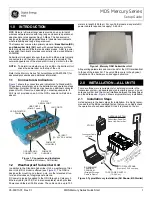
PART THREE - OPERATION
SECTION 3 - TRANSMITTER CONFIGURATION
PRO-series Model E3 Electrodeless Conductivity Transmitter
4
☞
TEMP TABLE Compensation Setup
When special temperature compensation is required, you
can create your own temperature table to define the tem-
perature compensation curve.
NOTE:
The TEMP TABLE must contain at least two data
points (Pt. 1 and Pt. 2) but can have up to ten.
(More points improve temperature compensation
accuracy.) Each point must have a temperature
value coordinate (shown as X) and a corresponding
ratio coordinate (shown as Y). Temperature values
must be between 0.0 and 200.0
°
C (or 32.0 and
392.0
°
F). Each entered temperature value must be
different from all others. Entered ratios, which are
unit-less, must be between 0.00 and 99.99 and can
have the same value.
Use this equation to calculate the ratio value for
each corresponding temperature value:
Ratio Value (for each
Cond. Value at Ref. Temp.
corresponding temperature)
Cond. Value at Noted Temp.
Example:
Suppose the uncompensated or raw
conductivity values are 100 mS/cm at a 25
°
C refer-
ence temperature, 120 mS/cm at 50
°
C, and 70
mS/cm at 15
°
C. Using this equation, ratio values for
each of the corresponding temperatures are:
For 25
°
C, ratio value = 100
÷
100 or 1.00
For 50
°
C, ratio value = 100
÷
120 or 0.83
For 15
°
C, ratio value = 100
÷
70 or 1.43
The default TEMP TABLE is:
Data
Point
Temperature Value
(X coordinate)
Corresponding Ratio
Value (Y coordinate)
Pt. 1
0.0
°
C
1.00
Pt. 2
100.0
°
C
1.00
To create your own TEMP TABLE, edit this default
table and, if needed, add more data points.
Recommendation:
Before entering values, plan ahead and
determine the temperature and ratio values for each data
point in your table. Use TABLE C to conveniently organize
and note your specific table entry values:
=
















































